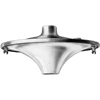
|
open type conical lantern
This is BLEECO's version of the popular open type conical lantern which provided a symmetrical distribution.
It's comprised of a cast iron canopy with a detachable spun steel white vitreous enamelled reflector and is fitted
with a porcelain lampholder.
|
|
671
|
60-100W GLS
|
BC
|
Top Entry
|
No Gear
|
1940s Leaflet
|
|
672
|
100-200W GLS
|
BC
|
Top Entry
|
No Gear
|
1940s Leaflet
|
|
673
|
100-200W GLS
|
BC
|
Top Entry
|
No Gear
|
1940s Leaflet
|
|
|

|
open type conical lantern
Refractor: Holophane 4116 series.
This is BLEECO's version of the popular open type conical lantern but which also provides a directional distribution.
It's comprised of a cast iron canopy with a detachable spun steel white vitreous enamelled reflector and is fitted
with a porcelain lampholder. It takes the Single-Piece refractor by Holophane. The refractor provides
symmetrical, axial or non-axial distributions.
|
|
674
|
60W GLS
|
BC
|
Top Entry
|
No Gear
|
1940s Leaflet
|
|
675
|
100-200W GLS
|
BC
|
Top Entry
|
No Gear
|
1940s Leaflet
|
|
676
|
100-200W GLS
|
BC
|
Top Entry
|
No Gear
|
1940s Leaflet
|
|
|
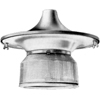
|
worthing / open type conical lantern
Refractor: Holophane 4607 series.
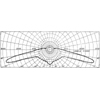
 One of the earliest lanterns offered on catalogue and was originally called the Worthing. It is possible it
was made for the town. This is BLEECO's version of the popular
open type conical lantern but which also provides a directional distribution.
It's comprised of a cast iron canopy with a detachable spun steel white vitreous enamelled reflector and is fitted
with a porcelain lampholder. It takes the Duo-Dome refractor by Holophane. The refractor provides
symmetrical, axial or non-axial distributions.
One of the earliest lanterns offered on catalogue and was originally called the Worthing. It is possible it
was made for the town. This is BLEECO's version of the popular
open type conical lantern but which also provides a directional distribution.
It's comprised of a cast iron canopy with a detachable spun steel white vitreous enamelled reflector and is fitted
with a porcelain lampholder. It takes the Duo-Dome refractor by Holophane. The refractor provides
symmetrical, axial or non-axial distributions.
|
|
677
|
60W GLS
|
BC
|
Top Entry
|
No Gear
|
1934 Brochure
1945 Advert
1940s Leaflet
|
|
678
|
100-200W GLS
|
BC
|
Top Entry
|
No Gear
|
1934 Brochure
1945 Advert
1940s Leaflet
|
|
679
|
100-200W GLS
|
BC
|
Top Entry
|
No Gear
|
1934 Brochure
1945 Advert
1940s Leaflet
|
|
|

|
worthing
Refractor: Holophane 4607 series, Holophane 4609 series.

 The larger size of the Worthing family of lanterns. Lantern canopy is made
of two separate casts. Fitted with a Holophane Duo-Dome refractor.
The larger size of the Worthing family of lanterns. Lantern canopy is made
of two separate casts. Fitted with a Holophane Duo-Dome refractor.
|
|
???
|
200W-300W GLS
|
BC
|
Top Entry
|
No Gear
|
1934 Brochure
1945 Advert
|
|
|
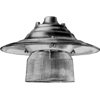
|
hove / sunstar lantern open type
Refractor: Holophane 4116 series, Holophane 4118 series, Holophane 4120 series.
One of the earliest models, appearing as the Hove in early catalogues and
Adverts. Naming may suggest that it was originally designed for the town of Hove. The profile was based
on a simplification of the Worthing lantern. The lantern had a single cast iron canopy with a detachable
over-hung spun steel reflector, vitreous enamelled white on the underside and green on the top side. The
original numbering scheme was around 3139 as seen in a 1945 Advert. Was later Advertised as part of the
open-type Sunstar range, and formed a family of three different sized lanterns, which took various sizes
of the Holophane Single-Piece dome refractor (either symmetrical, 2-way axial or 2-way non-axial).
|
|
681
|
60W GLS
80W MB/V
|
BC
|
Top Entry
|
No Gear
|
1940s Leaflet
1945 Advert
|
|
682
|
100W-200W GLS
80W MB/V
|
BC
|
Top Entry
|
No Gear
|
1940s Leaflet
1945 Advert
|
|
683
|
300-500W GLS
125 MBF/V
|
BC
|
Top Entry
|
No Gear
|
1940s Leaflet
1945 Advert
|
|
684
|
500-1000W GLS
|
BC
|
Top Entry
|
No Gear
|
1940s Leaflet
1945 Advert
|
|
|

|
|
|

|
|
|

|
|
|

|
|
|
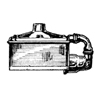
|
prismatic panel lantern
Probably takes the Holophane 780/781 plate refractor although this has yet to
be confirmed. Lantern was installed in Hove in 1937. The 1939 literature mentions "units of the horizontal burning type" which
can be fitted with single piece refractor plates with exposed prisms, or dual
refractor plates with the prisms sealed and the outside of the plates being totally
smooth. These lanterns give a very wide lateral light distribution without glare.
The picture shows the a smaller unit in 1945 but the 1937 version was more streamlined.
|
|
1075
|
100-150W SO/H
|
BC
|
Top Entry
|
No Gear
|
1937 Journal
1937 Journal
1939 Programme
1938 Advert
1939 Advert
1939 Programme
1939 Advert
1945 Advert
1945 Advert
1945 Journal
1946 Advert
1946 Advert
|
|
|

|
cut-off lantern
Described in the 1939 literature but not fully identified. It is a reflector
type lantern, the special features being vertical adjustment of the light source
to the reflector, enabling the cut-off angle to be increased or decreased as
required. The top reflector is also adjustable around the light source
to suit various gradients which may be met with.
|
|
???
|
???
|
???
|
??
|
No Gear
|
1939 Programme
|
|
|

|
box pattern lantern
This lantern is fitted with three 60W vertical burning Sodium lamps, giving a light
output of approximately 12,000 lumens. This lantern, which is made from a built-up
framework, has rippled glass panels on sides and also in the base, which is hinged
to facilitate lamp renewal, interior cleaning etc. Inside the lantern at each
side there are two refractor panels, fitted into hinged carrier frames which
can be set to give various adjustments to the light distribution, depending
on the angle at which the plates are set. This adjustment is of particular importance
where the fittings are mounted on inclines, as the disbtriubtion from the lamp
can be adjusted to suit the incline.
|
|
???
|
3x60 SO/H
|
3xBC
|
???
|
No Gear
|
1939 Programme
|
|
|
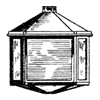
|
???
(This could be the 'Box Pattern Lantern' described above).
|
|
1086
|
???
|
???
|
Top Entry
|
No Gear
|
1945 Advert
1945 Advert
|
|
|

|
dome
Refractor: Holophane 4607 series, Holophane 4116 series, Holophane 4437 series.
Decorative range of lanterns designed for use with swan-neck
lanterns on side streets. Described as 'new' in 1945. The same canopy can be used with single-piece
dome refractor,
Duo-Dome refractor and Bowl refractor from Holophane,
each of which is available in symmetrical, axial and non-axial distributions.
External vitreous enamelled reflector an optional extra.
|
|
668 (was 2268)
|
60W-150W GLS
80W MB/U
|
BC
3BC
|
Top Entry
|
No Gear
|
1945 Advert
1945 Advert
1940s Leaflet
1940s Leaflet
|
|
669 (was 2270)
|
60W-150W GLS
80W MB/U
|
BC
3BC
|
Top Entry
|
No Gear
|
1945 Advert
1945 Advert
1940s Leaflet
1940s Leaflet
|
|
670 (was 2272)
|
60W-150W GLS
80W MB/U
|
BC
3BC
|
Top Entry
|
No Gear
|
1945 Advert
1945 Advert
1940s Leaflet
1940s Leaflet
|
|
|

|
triplite
Refractor: Holophane 4607 series, Holophane 4116 series.
For Group 'A' lighting, especially for "built up" areas. Designed to comply with the
Final M.O.T. report (1937) and the draft B.S. specification (1945). The Triplite lantern gave all the
advantages in street lighting of: (a) a line source light distribution, (b) a spectral colour (or natural colour),
(c) no ancilliary equipment (no chokes etc.), (d) flexibility of control (can be wired to reduce intensity at
less busy periods without giving uneven illumination) and (e) less glare (reduces the intrinsic brilliancy).
Easy to install and easy to maintain. Redesigned in 1946 for easier maintenance and lamp adjustment
and described as an "in line" lantern. Max-Candle power was at 75°-85° from the vertical and the lantern conformed to
British Standards Specificaiton type 1 (non-cut-off) and type 2 (semi-cut-off) light distribution.
Constructed with a substantial cast hood in non-corrosive Aluminium, fitted with a vitreous enamelled reflector
arranged to carry the three prismatic Holophane single-piece or Duo-Dome refractors, each with external lamp
focusing. Redesigned in 1946 for easier maintenance and lamp adjustment and described as an "in line" lantern.
|
|
624 (was 1101)
|
3 x 100W-200W GLS
|
BC
|
Top Entry
|
No Gear
|
1945 Advert
1940s Leaflet
1940s Leaflet
1946 Programme
1946 Advert
|
|
625 (was 1102)
|
3 x 100W-200W GLS
|
BC
|
Top Entry
|
No Gear
|
1945 Advert
1940s Leaflet
1940s Leaflet
1946 Programme
|
|
|
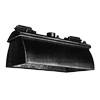
|
multilite / p. j. multilite
For Group "A" lighting. Introduced in 1946 and described as an "in line" lantern. Also called the "P.J. Multilite"
after Brighton's well-known and respected lighting engineer, Pryce-Jones, who
probably helped design this fitting after preferring cut-off fittings for the lighting
of Brighton's main traffic routes. Constructed from a substantial cast
Aluminium hood and fitted with a detachable
sheet vitreous enamel body with lightly diffused
mirror reflectors. (This is the same body
as the Mercury Cut-Off and Sodium Cut-Off.) Gives a Type 3 distribution with maximum candle-power at
65-70° and with a cut-off at 77.5-80°. The lanterns have external focussing. It gives
the advantages of a line source distribution with also the colour discrimination obtained with
Gas Filled lamps and are particularly suitable for the lighting of main shopping thoroughfares. Reduced intensity
available by switching off a select number of lamps. Should be spaced at not more than 90-110 feet
with a space-height ratio of 4:1 and is suitable for central mounting. When reduced intensities
are required at the less busy periods the switching off of alternative lanterns of the Cut-Off
type gives obtionable dark patches between units. With the Multilite lantern, using a series of
lamps per lantern, fractional lighting by switching off a selected number of lamps per lantern,
can still be made and still maintain the same evenness of lighting at reduced intensities.
|
|
619 (was 1103)
|
3 x 100W GLS
3 x 150W GLS
1 x 200W GLS
|
3 x BC
|
Top Entry
|
No Gear
|
1940s Leaflet
1946 Advert
1946 Programme
1946 Advert
1947 Advert
|
|
|

|
bi-flector lantern / "w" lantern
Provisional British Patent Application: 3480/47

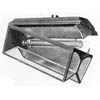 Introduced in 1947. Originally called the Bi-Flector. (Called the Bi-Flector on BLEECO's page but listed as the
"W" lantern in the list of installations. The renaming may simply be the result of an error in the APLE's
Conference catalogue). First exhibited at the Southport Conference in 1947. "This type of thoroughfare and the general lay-out calls for lighting units giving a wide two-way directional
light distrubution of low intrinsic brilliancy with a minimum of glare, which is admirably accomplished by the adoption of the
horizontal burning Philora Sodium lamp in conjunction with the new Bi-Flector lantern. This lantern, which is totally enclosed, empolys a double reflecting optical system above
and below the lamp arranged to give a two-way axial distribution. Fitted above the lamp are two specially shaped reflectors of glass,
or anodised aluminium, designed to re-direct the upwardly emitted light in two directions between 70° and 80° from
the downward vertical. Fitted below the lamp and forming the bottom of the lantern is arranged a gable or inverted "V" section of clear polished
glass, so set as to reflect by FIRST SURFACE REFLECTION from the inside polished surface along the street, and yet transmit sufficient light
downwards for the illumination of the immediate neighbourhood of the lantern. Thus, with this arrangement a large illuminated surface area
is obtained from the lantern of low intrinsic brilliancy, covering a very wide lateral and vertical
angle with a strong directional beam up and down the roadway. The Bi-Flector lantern is constructed with
a cast hood to which is hinged a "W" section, copper body glazed on the sides and one end with clear
fluted glass sheets, the bottom gable being glazed with clear smooth sheet glass. The
body section hinges away from the hood, which gives complete accessibility to the interior for maintenance and
lamp renewal. The lantern is of pleasing appearance, sound construction and novel design, and is
covered by Provisional British Patent Application No. 3480/47." Constructed with a cast hood of non-corrosive aluminium
alloy and a sheet copper body which is glazed with shallow fluted glass sides and end with a clear glass base.
The interior is easily accessible for both lamp and reflectors, the body being hinged to the hood and fastened by
a quick break safety catch.
Introduced in 1947. Originally called the Bi-Flector. (Called the Bi-Flector on BLEECO's page but listed as the
"W" lantern in the list of installations. The renaming may simply be the result of an error in the APLE's
Conference catalogue). First exhibited at the Southport Conference in 1947. "This type of thoroughfare and the general lay-out calls for lighting units giving a wide two-way directional
light distrubution of low intrinsic brilliancy with a minimum of glare, which is admirably accomplished by the adoption of the
horizontal burning Philora Sodium lamp in conjunction with the new Bi-Flector lantern. This lantern, which is totally enclosed, empolys a double reflecting optical system above
and below the lamp arranged to give a two-way axial distribution. Fitted above the lamp are two specially shaped reflectors of glass,
or anodised aluminium, designed to re-direct the upwardly emitted light in two directions between 70° and 80° from
the downward vertical. Fitted below the lamp and forming the bottom of the lantern is arranged a gable or inverted "V" section of clear polished
glass, so set as to reflect by FIRST SURFACE REFLECTION from the inside polished surface along the street, and yet transmit sufficient light
downwards for the illumination of the immediate neighbourhood of the lantern. Thus, with this arrangement a large illuminated surface area
is obtained from the lantern of low intrinsic brilliancy, covering a very wide lateral and vertical
angle with a strong directional beam up and down the roadway. The Bi-Flector lantern is constructed with
a cast hood to which is hinged a "W" section, copper body glazed on the sides and one end with clear
fluted glass sheets, the bottom gable being glazed with clear smooth sheet glass. The
body section hinges away from the hood, which gives complete accessibility to the interior for maintenance and
lamp renewal. The lantern is of pleasing appearance, sound construction and novel design, and is
covered by Provisional British Patent Application No. 3480/47." Constructed with a cast hood of non-corrosive aluminium
alloy and a sheet copper body which is glazed with shallow fluted glass sides and end with a clear glass base.
The interior is easily accessible for both lamp and reflectors, the body being hinged to the hood and fastened by
a quick break safety catch.
The light from the horizontal burning sodium lamp is symmetrical at right angles to its long axis
and gives approximately 50% of the total flux in the mid 60° zone and 25% each in the upper and lower
60° zones. The mid zone light below the horizontal is already given in the useful directions for street lighting. The
upward light requires redirecting along the roadway and the lower light usually gives too high an intensity
directly under the lanterns. The middle zone of light is transmitted in its normal direction without control
other than a slight diffusion from the body glazing. The upward light is redirected, by means of specially curved diffusing
mirrors, to augment the mid zone light and part transmitted to illuminate the area directly under the lantern. The
control of light from the lower zone is effected by utilising the optical principle of "First Surface Reflection" from
a polished surface. The inverted "V" shape or "W" of the lower part of the lantern body is glazed with clear polished
glass and the panes are plaed at such an angle with reference to the light source that the major part of the light
rays which impinge upon them is reflected off at an angle from 70° to 80° from the downward vertical.
|
|
605
|
45-60W SO/H
|
BC
|
Top Entry
|
No Gear
|
1940s Leaflet
1947 Advert
1947 Programme
1947 Journal
|
|
606
|
85W SO/H
|
BC
|
Top Entry
|
No Gear
|
1940s Leaflet
1940s Leaflet
1947 Advert
1947 Programme
|
|
607
|
140W SO/H
|
BC
|
Top Entry
|
No Gear
|
1940s Leaflet
1940s Leaflet
1947 Advert
1947 Programme
1947 Advert
|
|
|
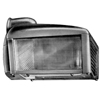
|
streamline lantern (original finial)
Refractor: Holophane 771
Introduced in 1947 and designed to match up with
modern types of reinforced concrete columns and brackets, or for gas
conversions using the Brighton "C" bracket. For Group "B" lighting.
Constructed from a cast aluminium-alloy
hood to which is bolted two end castings which carry the
cast frames which incorporate the sealed prismatic panels.
Deep end casting carries the lampholder and terminal block
for easy wiring, and the front end casting is framed and glazed so
that light is given in this direction.
Both side and top entry available. Side entry effected by a special
design cast iron finial which is detachable from the main body.
Fitted with the Holophane single prismatic control panel
(with Perspex covers to protect from dirt and mechanical fracture).
Gives a two-way directional light distribution with a maximum candle power
from 75° to 85° from the downward vertical, and covers a wide angle
across the roadway.
Lantern later modified
with the addition of an optional hinged bottom cover.
|
|
610
|
45-60W SO/H
|
BC
|
Side Entry
|
No Gear
|
1940s Leaflet
|
|
611
|
45-60W SO/H
|
BC
|
Top Entry
|
No Gear
|
1940s Leaflet
|
|
|
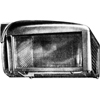
|
streamline lantern
Later modification of the original Streamline lantern. Incorporates
the side-entry spigot within the body of the casting, rather than the
provision of an adapter-finial for top-entry versions.
|
|
610
|
45-60W SO/H
|
BC
|
Side Entry
|
No Gear
|
1940s Leaflet
|
|
611
|
45-60W SO/H
|
BC
|
Top Entry
|
No Gear
|
1940s Leaflet
|
|
|


|
streamline lantern
Refractor: Holophane 771, Holophane 781
Introduced in 1947 and designed to match up with
modern types of reinforced concrete columns and brackets (shown with a Stanton 6B). Is of simple construction,
robust and easily maintained. Constructed from a cast aluminium-alloy (L.33)
hood to which is bolted two end castings which carry the
cast frames which incorporate the double sealed prismatic panels. The deeper end casting also carries the lampholder
and a terminal block for wiring. Made in two sizes: one to take the 85/140W sodium lamps; and one for the
45/60W sodium lamps.
Both side and top entry available. Side entry effected by a special
design cast iron finial which is detachable from the main body.
Each panel
can be fitted with either the Holophane single prismatic control panel
(with Perspex covers to protect from dirt and mechanical fracture) or the double
Holophane prismatic control panel (which has a smooth exterior surfaces).
The lantern gives a two-way light distribution, without excessive glare, with a
maxinum candle-power from 75° to 85° from the downward vertical.
Lantern later modified
with the addition of an optional hinged bottom cover.
|
|
612
|
85-140W SO/H
|
BC
|
Top Entry
|
No Gear
|
1940s Leaflet
1947 Advert
1947 Advert
1947 Journal
|
|
613
|
85-140W SO/H
|
BC
|
Side Entry
|
No Gear
|
1940s Leaflet
1947 Advert
1947 Advert
1947 Journal
|
|
614
|
85-140W SO/H
|
BC
|
Side Entry
|
No Gear
|
1940s Leaflet
1947 Advert
1947 Advert
1947 Journal
|
|
615
|
85-140W SO/H
|
BC
|
Top Entry
|
No Gear
|
1940s Leaflet
1947 Advert
1947 Advert
1947 Journal
|
|
|

|
sodium cut-off lantern
 Introduced in 1947. Constructed from a substantial cast Aluminium hood and fitted with a
detachable sheet vitreous enamel body with two lightly diffused mirror reflectors.
(This is the same body
as the Multilite and Mercury Cut-Off.)
Gives
a Type 3 distribution with maximum candle-power at 60-70° and with a cut-off at 75-80°.
Introduced in 1947. Constructed from a substantial cast Aluminium hood and fitted with a
detachable sheet vitreous enamel body with two lightly diffused mirror reflectors.
(This is the same body
as the Multilite and Mercury Cut-Off.)
Gives
a Type 3 distribution with maximum candle-power at 60-70° and with a cut-off at 75-80°.
|
|
616
|
85W SO/H
|
BC
|
Top Entry
|
No Gear
|
1940s Leaflet
1940s Leaflet
1947 Advert
|
|
617
|
140W SO/H
|
BC
|
Top Entry
|
No Gear
|
1940s Leaflet
1940s Leaflet
1947 Advert
|
|
|
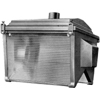
|
"w" lantern
Adaptation of the "W" Lantern for horizontally burning mercury lamps.
Can be fitted with a Magnetic Deflector if required.
|
|
626
|
250W MA/H
|
GES
|
Top Entry
|
No Gear
|
1940s Leaflet
|
|
627
|
400W MA/H
|
GES
|
Top Entry
|
No Gear
|
1940s Leaflet
|
|
|
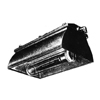
|
mercury cut-off lantern
Constructed from a substantial cast Aluminium hood and fitted with a
detachable sheet vitreous enamel body with two lightly diffused mirror reflectors. (This is the same body
as the Multilite and Sodium Cut-Off.) The horizontal lamp is contained in a heat-resisting clear glass cylinder
held in position by two cast end caps. These end caps are fixed to an over-reflector formed
as a channel or box with a hinged lid in which is mounted the magnetic deflector. The complete lamp and deflector unit is
hinged to the main body to permit easy access for wiring and maintenance, and is adjustable for two positions to
give a cut-off of 90° or 95°. The lanterns are suitable for either 250W or 400W MA/V mercury lamps
burned horizontally, and the channel carrying the deflector is drilled for two positions suitable for either
lamp.
|
|
636
|
250W MA/V
400W MA/V
|
GES
|
Top Entry
|
No Gear
|
1940s Leaflet
|
|
637
|
250W MA/V
400W MA/V
|
GES
|
Top Entry
|
No Gear
|
1940s Leaflet
|
|
|
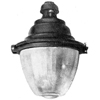
|
haleeco lantern
Refractor: Holophane 4114 series, Holophane 4124 series.
 Introduced in 1947. For Group "A" road and busy traffic centre lighting.
Constists of a 16" cast iron hood with hinged ring, brass swing bolt fixing,
external lamp focussing mechanism, goliath lamp holder and
cast iron lampholder bridge on adjustable rods. The interior
is fitted with a conical vitreous enamel reflector (which also holds a prismatic band refractor
if gas-filled lamps are used).
Fitted with a Holophane prismatic bowl refractor giving a 2-way
non-axial light distribution.
Introduced in 1947. For Group "A" road and busy traffic centre lighting.
Constists of a 16" cast iron hood with hinged ring, brass swing bolt fixing,
external lamp focussing mechanism, goliath lamp holder and
cast iron lampholder bridge on adjustable rods. The interior
is fitted with a conical vitreous enamel reflector (which also holds a prismatic band refractor
if gas-filled lamps are used).
Fitted with a Holophane prismatic bowl refractor giving a 2-way
non-axial light distribution.
|
|
643
|
300-500W GLS
|
GES
|
Top Entry
|
No Gear
|
1940s Leaflet
1947 Advert
|
|
644
|
400W MAF/V
|
GES
|
Top Entry
|
No Gear
|
1940s Leaflet
1947 Advert
|
|
645
|
250-400W MA/V
|
GES
|
Top Entry
|
No Gear
|
1940s Leaflet
1947 Advert
|
|
646
|
750-1000W GLS
|
GES
|
Top Entry
|
No Gear
|
1940s Leaflet
1947 Advert
|
|
|

|
sunstar lantern open type (later version)
Refractor: Holophane 4607 series, Holophane 4116 series.
The range has now been rationalised with just one open type lantern for Group 'B' lighting. The overhung
reflector has gone, but the canopy is still cast iron to which is attached a vitreous enamelled conical
reflector which carries the glassware. Either a Holophane single-piece refractor dome or Duo-Dome
can be fitted; and symmetrical, axial and non-axial lighting distributions are available.
|
|
659
|
60-200W GLS
80W MB/V
|
BC
|
Top Entry
|
No Gear
|
1940s Leaflet
|
|
660
|
60-200W GLS
80W MB/V
|
BC
|
Top Entry
|
No Gear
|
1940s Leaflet
|
|
|
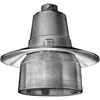
|
brighton junior
Refractor: Holophane 4607 series, Holophane 4116 series.

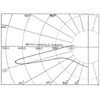 Simple-design side-road lantern constructed from single-piece aluminium
casting and can be fitted with either single-piece of Duo-Dome
Holophane refractor. Lampholder carried on a bridge
which is screwed to lugs in the interior to suit size of lamp. Fixing method
different for single-piece refractor (springed hooks) or Duo-Dome (winged nuts through
copper collar clamp.) Refractors can be supplied for symmetrical, two-way axial and
two-way non-axial light distributions. May have been designed in response to BS1788:1951.
Simple-design side-road lantern constructed from single-piece aluminium
casting and can be fitted with either single-piece of Duo-Dome
Holophane refractor. Lampholder carried on a bridge
which is screwed to lugs in the interior to suit size of lamp. Fixing method
different for single-piece refractor (springed hooks) or Duo-Dome (winged nuts through
copper collar clamp.) Refractors can be supplied for symmetrical, two-way axial and
two-way non-axial light distributions. May have been designed in response to BS1788:1951.
|
|
661
|
60W-200W GLS
80-125W MB/U
|
BC
3BC
|
Top Entry
|
No Gear
|
1940s Leaflet
|
|
662
|
60W-200W GLS
80-125W MB/U
|
BC
3BC
|
Top Entry
|
No Gear
|
1940s Leaflet
|
|
|
|
|
sunstar lantern enclosed type clear bowl
Refractor: Holophane 4116 series, Holophane 4118 series.
Part of the Sunstar range of lanterns. This paricular range is made in two sizes. It's fitted with a clear blown-glass
outer bowl with an inner single-piece Holophane refractor (either symmetrical, 2-way axial or 2-way non-axial).
The lantern comprises a cast iron canopy or hood with a hinged ring, which carries the outer bowl. The interior is fitted with
a white sheet-metal reflector and the lampholder is carried on a bridge-piece suitable for the particular size
of lamp to be used..
|
|
691
|
100-200W GLS
80W MB/V
|
BC
|
Top Entry
|
No Gear
|
1940s Leaflet
|
|
693
|
300W-500W GLS
125W MB/V
|
BC
|
Top Entry
|
No Gear
|
1940s Leaflet
|
|
|

|
sunstar lantern enclosed type refractor bowl
Refractor: Holophane 4438 series, Holophane 4433 series.
Part of the Sunstar range of lanterns. This paricular range is made in two sizes. It's fitted with a Holophane
outer bowl refractor (either symmetrical, 2-way axial or 2-way non-axial).
The lantern comprises a cast iron canopy or hood with a hinged ring, which carries the outer bowl. The interior is fitted with
a white sheet-metal reflector and the lampholder is carried on a bridge-piece suitable for the particular size
of lamp to be used.
|
|
694
|
60-200W GLS
80W MB/V
|
BC
|
Top Entry
|
No Gear
|
1940s Leaflet
|
|
695
|
100-200W GLS
80W MB/V
|
BC
|
Top Entry
|
No Gear
|
1940s Leaflet
|
|
696
|
300W-500W GLS
125W MB/V
|
BC
|
Top Entry
|
No Gear
|
1940s Leaflet
|
|
|
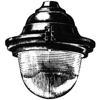
|
sunstar lantern enclosed type (later version)
Refractor: Holophane 4125 series.
The range has now been rationalised with just one closed type lantern for Group 'B' lighting.
The hood is of cast iron with a hinged ring which carries the glass bowl. The interior is fitted with a white vitreous
enamelled reflector. The only option is a Holophane refractor bowl with a
2-way, non-axial light distribution.
|
|
694
|
60-200W GLS
80W MB/V
|
BC
3BC
|
Top Entry
|
No Gear
|
1940s Leaflet
|
|
|
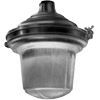
|
prismatic bowl lantern
Refractor: Holophane 4140 series, Holophane 4118 and 4119.
For main road lighting. The hood, which is similar for both lanterns, can be supplied in cast
iron or in aluminium alloy and is fitted with a hinged ring, which carries the outer prismatic bowl. Two different options
are available: a mercury version fitted with Holophane Bi-Way refractor bowl; or a tungsten version
fitted with the Holophane stepped refractor bowl and internal dome refractor. Both options were available
with symmetrical, axial or non-axial distributions.
|
|
697
|
250-400W MA/V
|
GES
|
Top Entry
|
No Gear
|
1940s Leaflet
|
|
698
|
300-500 GLS
|
GES
|
Top Entry
|
No Gear
|
1940s Leaflet
|
|
|

|
vertical type fluorescent lantern
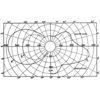 Designed for post-top mounting and the lighting
of Housing Estates, Gardens and similar sites. Constructed around
a cast aluminium base and top ring connected together by a central
vitreous enamelled tube which carries the lamp-holder assembly,
white top reflector and detachable spun metal cap. Control gear
can be accommodated in the base of the lantern. Has three windows.
Made in two
types: 704 for normal street lighting (back section glazed with diffusing opal,
two sections facing the road have clear Perspex windows with anodised aluminium reflectors
to give a 2-way non-axial distribution) and 705 for general lighting of larger areas
(all three windows glazed with opal Perspex).
Designed for post-top mounting and the lighting
of Housing Estates, Gardens and similar sites. Constructed around
a cast aluminium base and top ring connected together by a central
vitreous enamelled tube which carries the lamp-holder assembly,
white top reflector and detachable spun metal cap. Control gear
can be accommodated in the base of the lantern. Has three windows.
Made in two
types: 704 for normal street lighting (back section glazed with diffusing opal,
two sections facing the road have clear Perspex windows with anodised aluminium reflectors
to give a 2-way non-axial distribution) and 705 for general lighting of larger areas
(all three windows glazed with opal Perspex).
|
|
704
|
2x40W MCF/U
|
2xBC
|
Post Top
|
Gear
|
1940s Leaflet
|
|
705
|
4x40W MCF/U
|
4xBC
|
Post Top
|
Gear
|
1940s Leaflet
|
|
|

|
cast bronze octagonal lantern
Suitable for mounting on columns or pedestals for Park Entrances, Esplanades and Piers, etc.
The octagonal body is made in cast bronze with a cast hinged top canopy and cap to give access to the interior
and is glazed with figured diffusing glass panels. The eight-way ornamental frog is in cast iron and
incorporates a 3¾" spigot cap.
|
|
710
|
500W GLS
|
GES
|
Post Top
|
No Gear
|
1940s Leaflet
|
|
|



